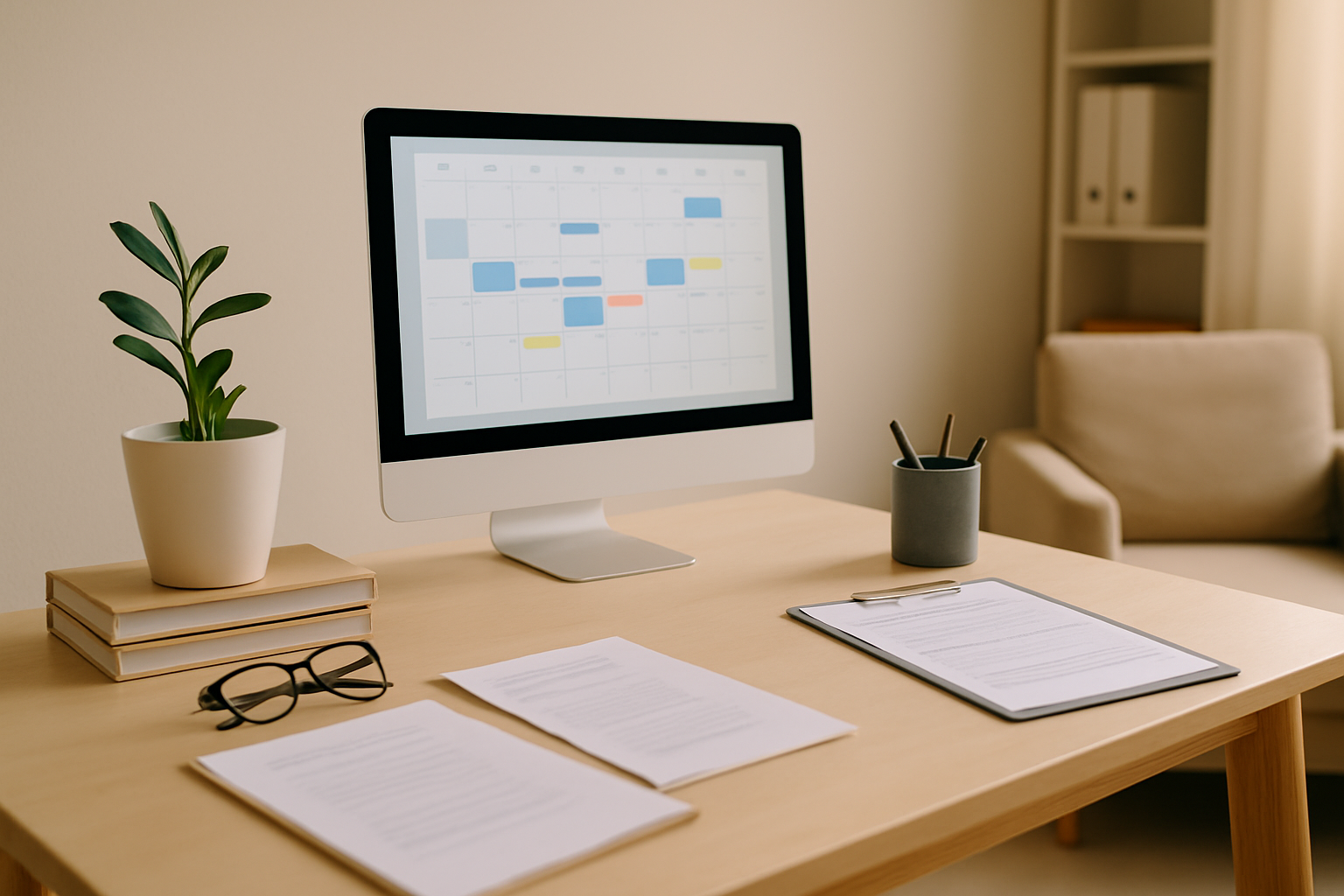
How Can Therapists Increase Therapist Referrals For Their Private Practice?
Learn actionable steps therapists can take to boost therapist referrals, enhance credibility, and ex...
Therapists organization is key for professionals aiming to increase productivity and improve client care while managing a practice without chaos.
Therapists often find themselves juggling packed schedules and heaps of paperwork as well as the delicate nature of client details. When organization slips through the cracks it usually means wasted time, more errors, added stress and potential confidentiality slip-ups. These problems can quietly chip away at both the quality of care and a therapist's professional reputation.
Effective organization for therapists hinges on a few key principles: reliability, simplicity and safeguarding sensitive information—no cutting corners here. It’s all about sticking to consistent routines and relying on a handful of trusty tools. Keeping records neatly organized, making client confidentiality a top priority and being flexible enough to tweak methods to suit different work styles are also essential.
Using simple organizational strategies can quickly and effectively boost any therapist’s practice. These methods help smooth workflow hiccups, safeguard patient privacy, and free up time to focus on clinical work
There's something oddly satisfying about tidying up your desk—like pressing a reset button for your brain. Getting rid of the clutter and setting things in order doesn’t just make your space look nicer; it actually makes focusing a bit easier, too. In my experience, even small tweaks—like shifting a notepad here or straightening a pen there—can work wonders for your mood and productivity. Plus, who does not enjoy that fresh start feeling every now and then?
A therapist’s physical environment really sets the stage for maintaining focus and helping clients feel comfortable, almost like a silent partner in the session. Clearing away clutter and keeping those important materials neatly organized can do wonders for mental clarity and make the space feel more welcoming—think of it as tidying up your mind by tidying up your surroundings.
Managing electronic client records with care goes a long way in safeguarding privacy and meeting legal requirements while making information easy to find.
| Platform | Security Features | Ease of Use | Integration with Other Tools |
|---|---|---|---|
| TherapyNotes | HIPAA-compliant encryption combined with two-factor authentication to keep things locked up tight | A straightforward, no-nonsense interface that even your less tech-savvy clients could navigate | Plays nicely with your Calendar, Billing, and Telehealth tools, making life a bit smoother |
| SimplePractice | End-to-end encryption along with audit logging, so you know exactly who’s been poking around | Dashboard designed with ease of use in mind—like your favorite comfy chair to work from | Supports Insurance claims and Telehealth, ticking off those must-have boxes with flair |
| TheraNest | Access tightly controlled by user roles, because sharing is caring but only to the right people | Clean, uncomplicated design that won’t make you squint or scratch your head | Seamlessly integrates with Billing, Scheduling, and Telehealth—like a well-coordinated dance |
| Google Drive | Two-step verification paired with solid data encryption, keeping your files under good lock and key | Flexible sharing options that let you share just enough without oversharing | Syncs smoothly with Google Calendar and other apps, fitting right into your daily routine |
| Dropbox Business | Checks all the boxes with HIPAA standards and detailed access controls, so your sensitive info stays just that—sensitive | Simple sharing and storage features that make filing and finding a breeze | Hooks up with a variety of third-party EHR systems, so you’re not stuck reinventing the wheel |
Juggling schedules and calendars can sometimes feel like trying to herd cats, but with the right approach, it actually becomes a manageable—dare I say enjoyable—part of daily life. Staying on top means learning how to make important tasks, make room for unexpected curveballs, and keep everything syncing smoothly. In my experience, a well-kept calendar not only saves time but also spares you from that sinking feeling when you realize a meeting snuck up on you.
Optimizing appointment scheduling is a real game-changer. It helps therapists make the most of their valuable time while keeping no-shows to a minimum and lightening the load of administrative headaches. Using calendar apps and slotting in buffer times, along with automating reminders, all team up to keep sessions running like clockwork even with the usual paperwork and much-needed breaks tucked in.
Keeping session notes clear and organized is essential for maintaining continuity of care and meeting ethical and legal requirements. I’ve found that using structured templates and a regular note-taking schedule along with voice-to-text tools can really speed things up.
Therapists often get bogged down by the mountain of financial and administrative tasks that steal precious time from their clinical work. Keeping invoicing straightforward, tracking payments closely, managing insurance claims without losing sleep and preparing well in advance for tax season are vital steps. These steps safeguard financial health and lighten the mental load.
There are plenty of digital tools out there designed to help therapists run their practices with a bit less hassle. From trusty Electronic Health Record (EHR) systems to scheduling apps even the least tech-savvy can navigate, and don’t forget those secure cloud storage options that quietly keep everything locked down.
Achieving success in therapy practices is an ongoing journey that calls for steady care and a willingness to roll with the punches. Making a habit of regularly checking systems and gathering feedback from clients and colleagues keeps therapists organization running smoothly. Staying on top of the latest technology and regulations also empowers therapists to adapt with confidence as demands evolve.
"Regularly fine-tuning how a practice runs can take it from just okay to a spot where clients genuinely feel seen and appreciated. When everything clicks into place behind the scenes, therapists get to focus on what truly matters—delivering outstanding care that makes a real difference." – Dr. Melissa Anders, Clinical Practice Consultant

Start small by focusing on one area at a time such as clearing your workspace or setting up a simple scheduling system. It is much better to stay consistent than aim for perfection right away. You can gradually add useful tools like EHRs or templates as you find your rhythm. Honestly, spending just 10-15 minutes a day on organizing can quietly build up to impressive progress.
Most of the time yes. EHRs like SimplePractice or TherapyNotes can significantly reduce hours lost to paperwork, billing and scheduling. This usually balances out the cost by improving efficiency and minimizing errors. Many offer plans tailored specifically for solo therapists and free trials so you can try them out before committing.
Automated reminders through apps like Calendly work really well and having a clear cancellation policy makes things easier for everyone. It’s also smart to leave a little buffer time between sessions to handle unexpected last-minute changes. Some therapists find that requiring prepayment or deposits helps reduce no-shows and tracking patterns can help you fine-tune your scheduling approach.
Checking in every few months strikes a good balance because it helps you see what is working and where things might be slipping. Larger changes like a growing caseload or new regulations may mean you need to update things sooner. Don’t overlook the value of regular feedback from clients or staff since it acts like a built-in road map for improvements.
Absolutely as long as you choose HIPAA-compliant services like Google Drive for Business with a BAA in place and use encryption properly. Limit access to sensitive files, rely on strong passwords and make sure everyone involved understands privacy protocols. This way you stay compliant without giving up the convenience these tools offer.

Learn actionable steps therapists can take to boost therapist referrals, enhance credibility, and ex...

Discover the essential challenges therapists face when starting a private practice and learn practic...

Discover practical marketing strategies to attract more clients as a therapist. This guide offers st...

Wondering if therapists take insurance? Discover how insurance impacts therapy access and learn prac...